Analysis of Leadership, Management, and Operational Functions at TESCO
VerifiedAdded on 2023/01/13
|15
|4401
|55
Report
AI Summary
This report provides an in-depth analysis of management and operations within TESCO, focusing on the distinct roles and characteristics of leaders and managers. It explores how these roles apply in various situational contexts, examining the application of leadership theories such as situational, contingency, and system leadership. The report delves into the key approaches to operational management, highlighting the importance of these approaches in achieving business objectives. Furthermore, it assesses the factors within the business environment that impact operational management and decision-making by managers and leaders. The content covers the differences and similarities between leaders and managers, the application of different leadership styles, and the strengths and weaknesses of each approach. Overall, the report offers a comprehensive overview of management and operational strategies within TESCO, including the impact of various factors on decision-making and business outcomes.
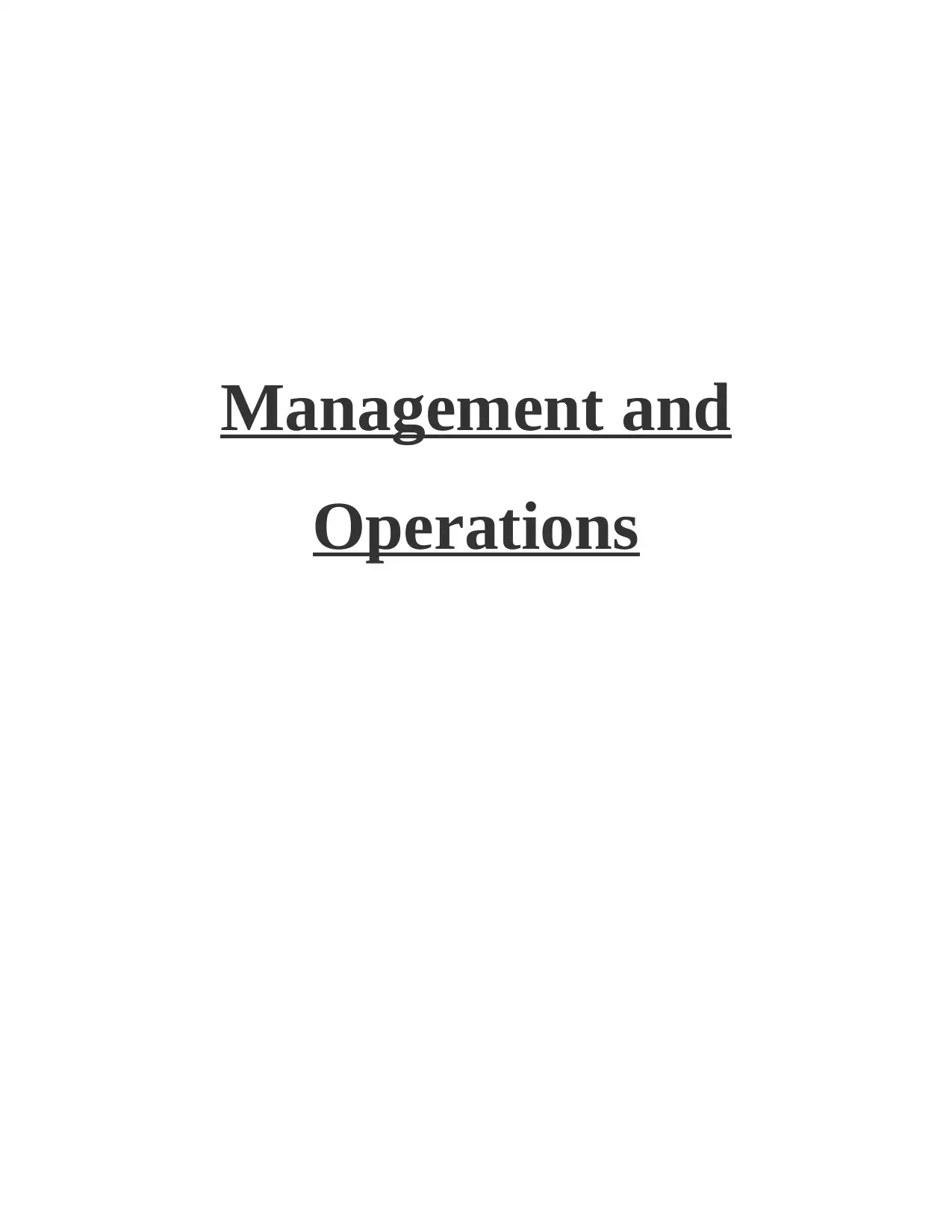
Management and
Operations
Operations
Paraphrase This Document
Need a fresh take? Get an instant paraphrase of this document with our AI Paraphraser
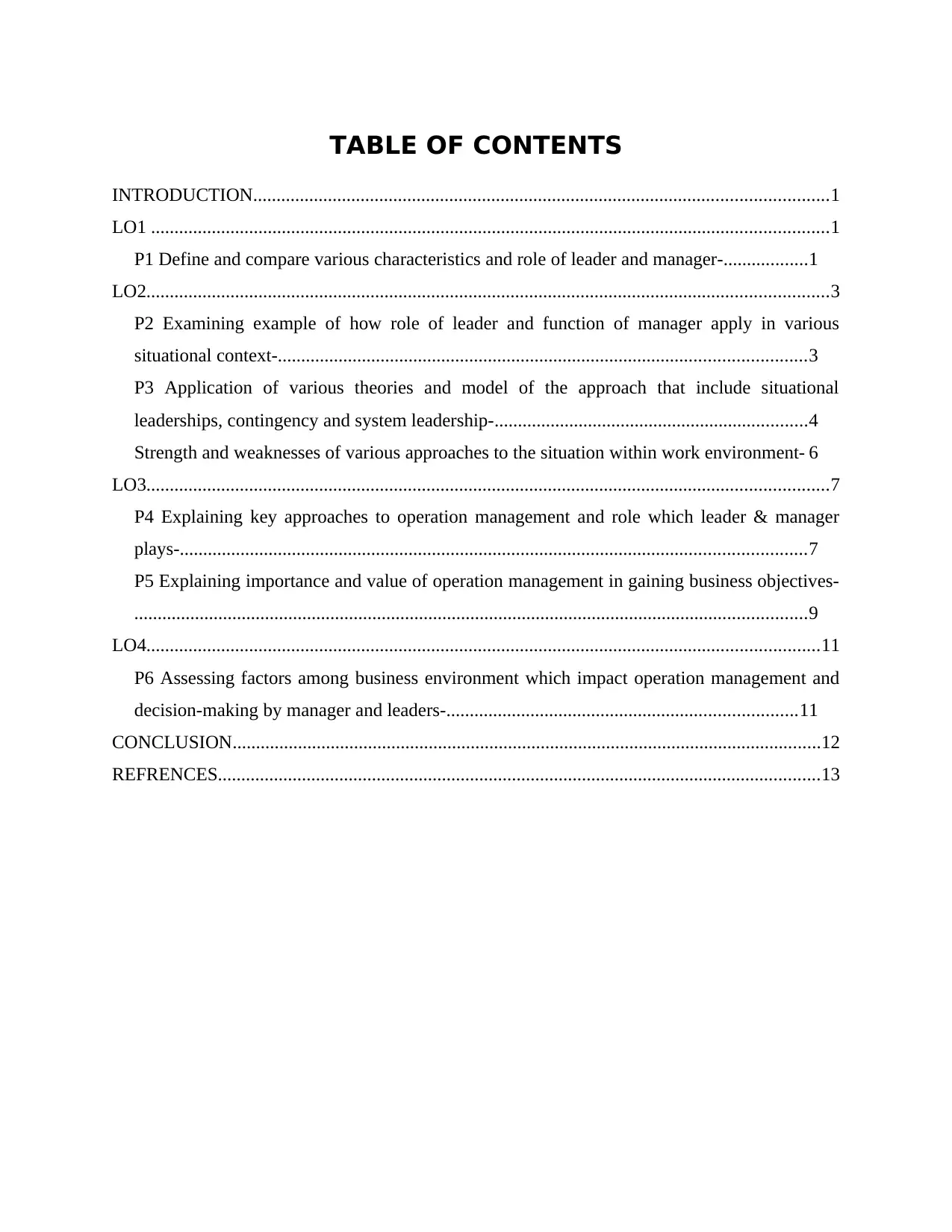
TABLE OF CONTENTS
INTRODUCTION...........................................................................................................................1
LO1 .................................................................................................................................................1
P1 Define and compare various characteristics and role of leader and manager-..................1
LO2..................................................................................................................................................3
P2 Examining example of how role of leader and function of manager apply in various
situational context-.................................................................................................................3
P3 Application of various theories and model of the approach that include situational
leaderships, contingency and system leadership-...................................................................4
Strength and weaknesses of various approaches to the situation within work environment- 6
LO3..................................................................................................................................................7
P4 Explaining key approaches to operation management and role which leader & manager
plays-......................................................................................................................................7
P5 Explaining importance and value of operation management in gaining business objectives-
................................................................................................................................................9
LO4................................................................................................................................................11
P6 Assessing factors among business environment which impact operation management and
decision-making by manager and leaders-...........................................................................11
CONCLUSION..............................................................................................................................12
REFRENCES.................................................................................................................................13
INTRODUCTION...........................................................................................................................1
LO1 .................................................................................................................................................1
P1 Define and compare various characteristics and role of leader and manager-..................1
LO2..................................................................................................................................................3
P2 Examining example of how role of leader and function of manager apply in various
situational context-.................................................................................................................3
P3 Application of various theories and model of the approach that include situational
leaderships, contingency and system leadership-...................................................................4
Strength and weaknesses of various approaches to the situation within work environment- 6
LO3..................................................................................................................................................7
P4 Explaining key approaches to operation management and role which leader & manager
plays-......................................................................................................................................7
P5 Explaining importance and value of operation management in gaining business objectives-
................................................................................................................................................9
LO4................................................................................................................................................11
P6 Assessing factors among business environment which impact operation management and
decision-making by manager and leaders-...........................................................................11
CONCLUSION..............................................................................................................................12
REFRENCES.................................................................................................................................13
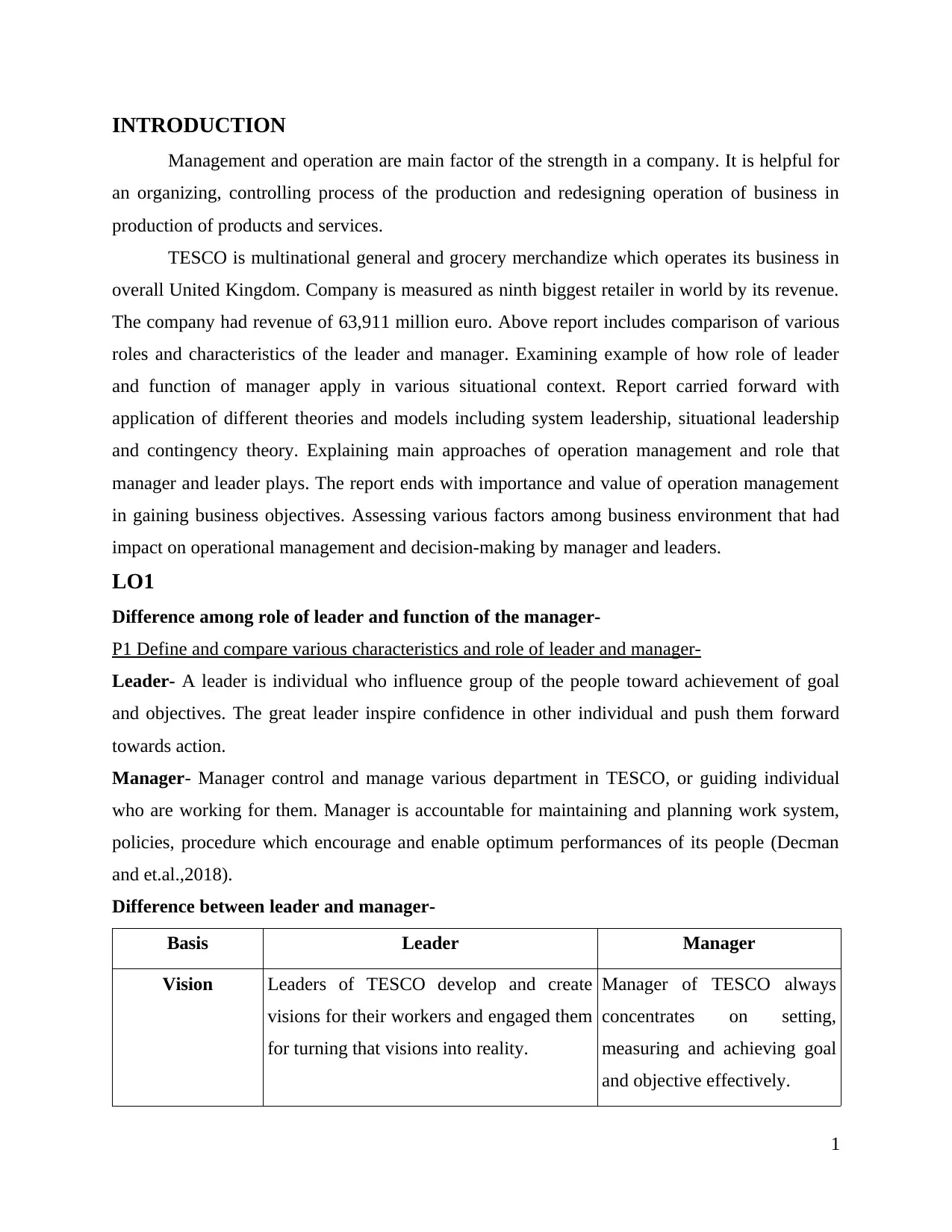
INTRODUCTION
Management and operation are main factor of the strength in a company. It is helpful for
an organizing, controlling process of the production and redesigning operation of business in
production of products and services.
TESCO is multinational general and grocery merchandize which operates its business in
overall United Kingdom. Company is measured as ninth biggest retailer in world by its revenue.
The company had revenue of 63,911 million euro. Above report includes comparison of various
roles and characteristics of the leader and manager. Examining example of how role of leader
and function of manager apply in various situational context. Report carried forward with
application of different theories and models including system leadership, situational leadership
and contingency theory. Explaining main approaches of operation management and role that
manager and leader plays. The report ends with importance and value of operation management
in gaining business objectives. Assessing various factors among business environment that had
impact on operational management and decision-making by manager and leaders.
LO1
Difference among role of leader and function of the manager-
P1 Define and compare various characteristics and role of leader and manager-
Leader- A leader is individual who influence group of the people toward achievement of goal
and objectives. The great leader inspire confidence in other individual and push them forward
towards action.
Manager- Manager control and manage various department in TESCO, or guiding individual
who are working for them. Manager is accountable for maintaining and planning work system,
policies, procedure which encourage and enable optimum performances of its people (Decman
and et.al.,2018).
Difference between leader and manager-
Basis Leader Manager
Vision Leaders of TESCO develop and create
visions for their workers and engaged them
for turning that visions into reality.
Manager of TESCO always
concentrates on setting,
measuring and achieving goal
and objective effectively.
1
Management and operation are main factor of the strength in a company. It is helpful for
an organizing, controlling process of the production and redesigning operation of business in
production of products and services.
TESCO is multinational general and grocery merchandize which operates its business in
overall United Kingdom. Company is measured as ninth biggest retailer in world by its revenue.
The company had revenue of 63,911 million euro. Above report includes comparison of various
roles and characteristics of the leader and manager. Examining example of how role of leader
and function of manager apply in various situational context. Report carried forward with
application of different theories and models including system leadership, situational leadership
and contingency theory. Explaining main approaches of operation management and role that
manager and leader plays. The report ends with importance and value of operation management
in gaining business objectives. Assessing various factors among business environment that had
impact on operational management and decision-making by manager and leaders.
LO1
Difference among role of leader and function of the manager-
P1 Define and compare various characteristics and role of leader and manager-
Leader- A leader is individual who influence group of the people toward achievement of goal
and objectives. The great leader inspire confidence in other individual and push them forward
towards action.
Manager- Manager control and manage various department in TESCO, or guiding individual
who are working for them. Manager is accountable for maintaining and planning work system,
policies, procedure which encourage and enable optimum performances of its people (Decman
and et.al.,2018).
Difference between leader and manager-
Basis Leader Manager
Vision Leaders of TESCO develop and create
visions for their workers and engaged them
for turning that visions into reality.
Manager of TESCO always
concentrates on setting,
measuring and achieving goal
and objective effectively.
1
⊘ This is a preview!⊘
Do you want full access?
Subscribe today to unlock all pages.

Trusted by 1+ million students worldwide
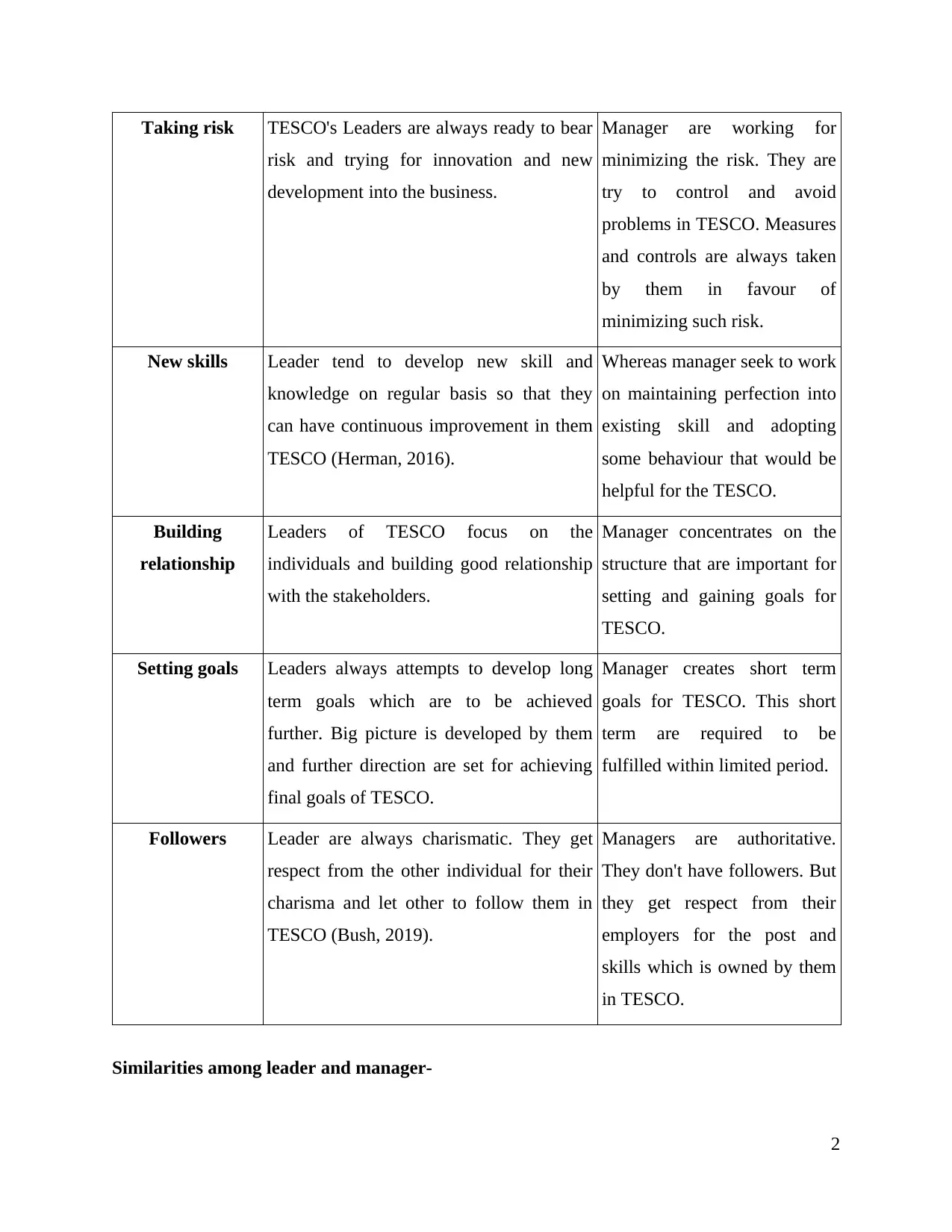
Taking risk TESCO's Leaders are always ready to bear
risk and trying for innovation and new
development into the business.
Manager are working for
minimizing the risk. They are
try to control and avoid
problems in TESCO. Measures
and controls are always taken
by them in favour of
minimizing such risk.
New skills Leader tend to develop new skill and
knowledge on regular basis so that they
can have continuous improvement in them
TESCO (Herman, 2016).
Whereas manager seek to work
on maintaining perfection into
existing skill and adopting
some behaviour that would be
helpful for the TESCO.
Building
relationship
Leaders of TESCO focus on the
individuals and building good relationship
with the stakeholders.
Manager concentrates on the
structure that are important for
setting and gaining goals for
TESCO.
Setting goals Leaders always attempts to develop long
term goals which are to be achieved
further. Big picture is developed by them
and further direction are set for achieving
final goals of TESCO.
Manager creates short term
goals for TESCO. This short
term are required to be
fulfilled within limited period.
Followers Leader are always charismatic. They get
respect from the other individual for their
charisma and let other to follow them in
TESCO (Bush, 2019).
Managers are authoritative.
They don't have followers. But
they get respect from their
employers for the post and
skills which is owned by them
in TESCO.
Similarities among leader and manager-
2
risk and trying for innovation and new
development into the business.
Manager are working for
minimizing the risk. They are
try to control and avoid
problems in TESCO. Measures
and controls are always taken
by them in favour of
minimizing such risk.
New skills Leader tend to develop new skill and
knowledge on regular basis so that they
can have continuous improvement in them
TESCO (Herman, 2016).
Whereas manager seek to work
on maintaining perfection into
existing skill and adopting
some behaviour that would be
helpful for the TESCO.
Building
relationship
Leaders of TESCO focus on the
individuals and building good relationship
with the stakeholders.
Manager concentrates on the
structure that are important for
setting and gaining goals for
TESCO.
Setting goals Leaders always attempts to develop long
term goals which are to be achieved
further. Big picture is developed by them
and further direction are set for achieving
final goals of TESCO.
Manager creates short term
goals for TESCO. This short
term are required to be
fulfilled within limited period.
Followers Leader are always charismatic. They get
respect from the other individual for their
charisma and let other to follow them in
TESCO (Bush, 2019).
Managers are authoritative.
They don't have followers. But
they get respect from their
employers for the post and
skills which is owned by them
in TESCO.
Similarities among leader and manager-
2
Paraphrase This Document
Need a fresh take? Get an instant paraphrase of this document with our AI Paraphraser
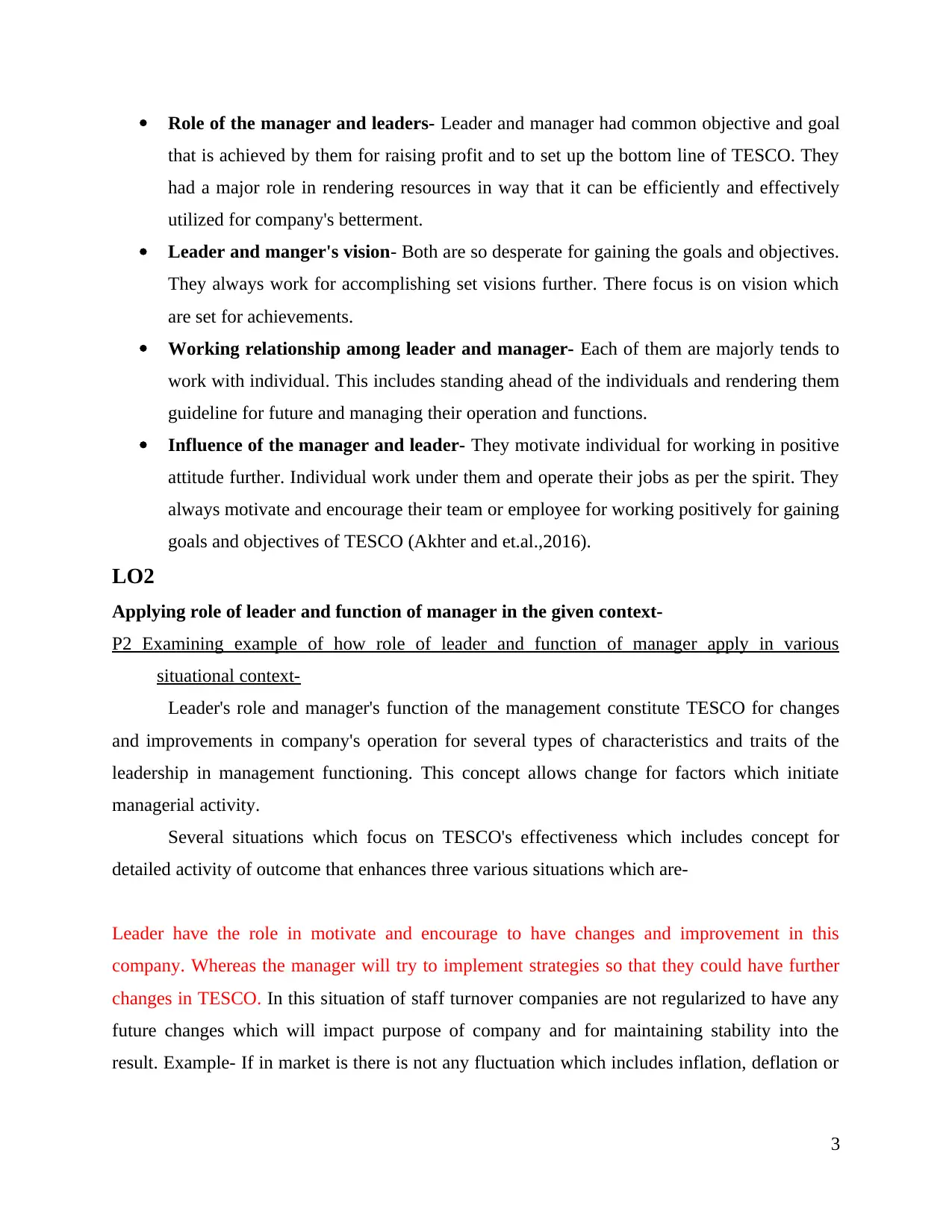
Role of the manager and leaders- Leader and manager had common objective and goal
that is achieved by them for raising profit and to set up the bottom line of TESCO. They
had a major role in rendering resources in way that it can be efficiently and effectively
utilized for company's betterment.
Leader and manger's vision- Both are so desperate for gaining the goals and objectives.
They always work for accomplishing set visions further. There focus is on vision which
are set for achievements.
Working relationship among leader and manager- Each of them are majorly tends to
work with individual. This includes standing ahead of the individuals and rendering them
guideline for future and managing their operation and functions.
Influence of the manager and leader- They motivate individual for working in positive
attitude further. Individual work under them and operate their jobs as per the spirit. They
always motivate and encourage their team or employee for working positively for gaining
goals and objectives of TESCO (Akhter and et.al.,2016).
LO2
Applying role of leader and function of manager in the given context-
P2 Examining example of how role of leader and function of manager apply in various
situational context-
Leader's role and manager's function of the management constitute TESCO for changes
and improvements in company's operation for several types of characteristics and traits of the
leadership in management functioning. This concept allows change for factors which initiate
managerial activity.
Several situations which focus on TESCO's effectiveness which includes concept for
detailed activity of outcome that enhances three various situations which are-
Leader have the role in motivate and encourage to have changes and improvement in this
company. Whereas the manager will try to implement strategies so that they could have further
changes in TESCO. In this situation of staff turnover companies are not regularized to have any
future changes which will impact purpose of company and for maintaining stability into the
result. Example- If in market is there is not any fluctuation which includes inflation, deflation or
3
that is achieved by them for raising profit and to set up the bottom line of TESCO. They
had a major role in rendering resources in way that it can be efficiently and effectively
utilized for company's betterment.
Leader and manger's vision- Both are so desperate for gaining the goals and objectives.
They always work for accomplishing set visions further. There focus is on vision which
are set for achievements.
Working relationship among leader and manager- Each of them are majorly tends to
work with individual. This includes standing ahead of the individuals and rendering them
guideline for future and managing their operation and functions.
Influence of the manager and leader- They motivate individual for working in positive
attitude further. Individual work under them and operate their jobs as per the spirit. They
always motivate and encourage their team or employee for working positively for gaining
goals and objectives of TESCO (Akhter and et.al.,2016).
LO2
Applying role of leader and function of manager in the given context-
P2 Examining example of how role of leader and function of manager apply in various
situational context-
Leader's role and manager's function of the management constitute TESCO for changes
and improvements in company's operation for several types of characteristics and traits of the
leadership in management functioning. This concept allows change for factors which initiate
managerial activity.
Several situations which focus on TESCO's effectiveness which includes concept for
detailed activity of outcome that enhances three various situations which are-
Leader have the role in motivate and encourage to have changes and improvement in this
company. Whereas the manager will try to implement strategies so that they could have further
changes in TESCO. In this situation of staff turnover companies are not regularized to have any
future changes which will impact purpose of company and for maintaining stability into the
result. Example- If in market is there is not any fluctuation which includes inflation, deflation or
3
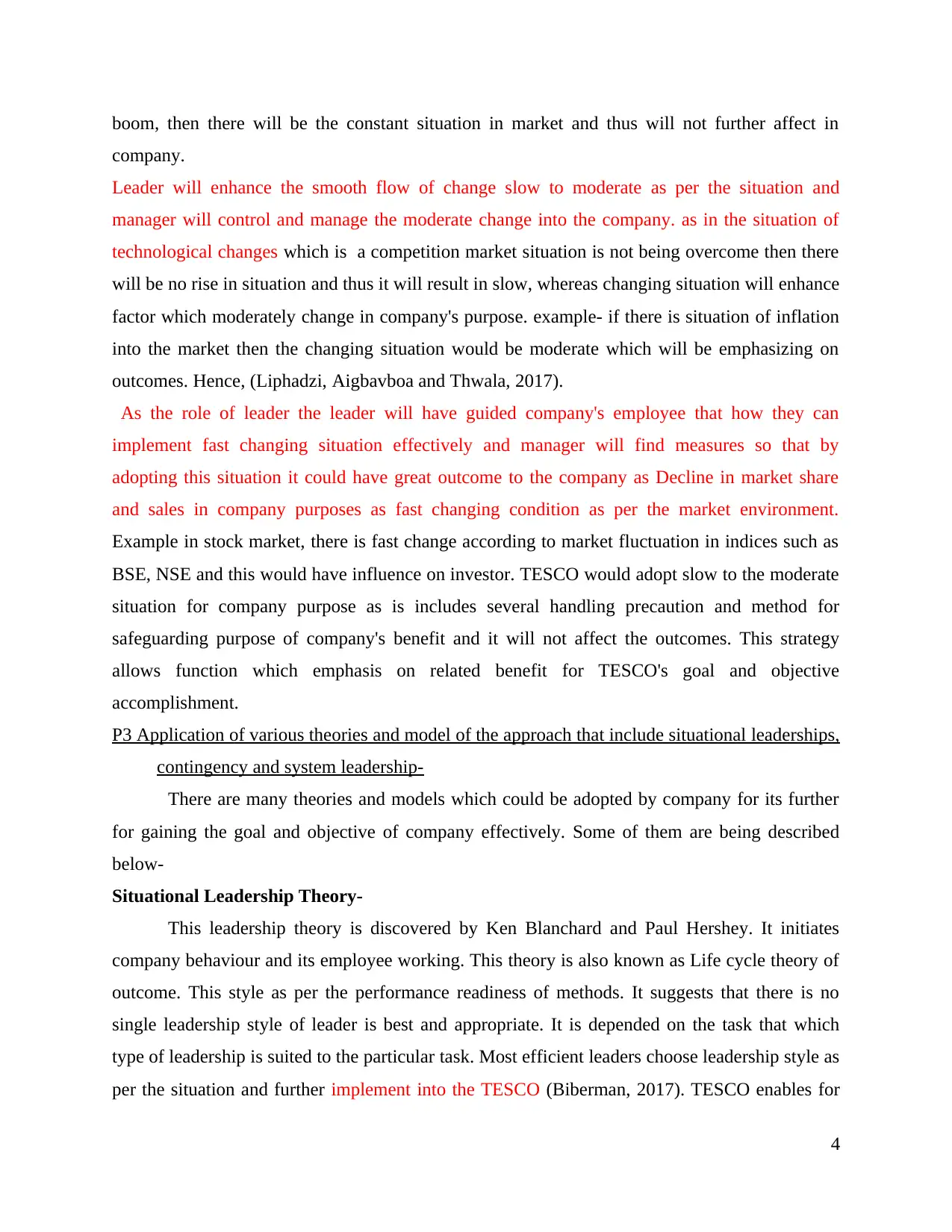
boom, then there will be the constant situation in market and thus will not further affect in
company.
Leader will enhance the smooth flow of change slow to moderate as per the situation and
manager will control and manage the moderate change into the company. as in the situation of
technological changes which is a competition market situation is not being overcome then there
will be no rise in situation and thus it will result in slow, whereas changing situation will enhance
factor which moderately change in company's purpose. example- if there is situation of inflation
into the market then the changing situation would be moderate which will be emphasizing on
outcomes. Hence, (Liphadzi, Aigbavboa and Thwala, 2017).
As the role of leader the leader will have guided company's employee that how they can
implement fast changing situation effectively and manager will find measures so that by
adopting this situation it could have great outcome to the company as Decline in market share
and sales in company purposes as fast changing condition as per the market environment.
Example in stock market, there is fast change according to market fluctuation in indices such as
BSE, NSE and this would have influence on investor. TESCO would adopt slow to the moderate
situation for company purpose as is includes several handling precaution and method for
safeguarding purpose of company's benefit and it will not affect the outcomes. This strategy
allows function which emphasis on related benefit for TESCO's goal and objective
accomplishment.
P3 Application of various theories and model of the approach that include situational leaderships,
contingency and system leadership-
There are many theories and models which could be adopted by company for its further
for gaining the goal and objective of company effectively. Some of them are being described
below-
Situational Leadership Theory-
This leadership theory is discovered by Ken Blanchard and Paul Hershey. It initiates
company behaviour and its employee working. This theory is also known as Life cycle theory of
outcome. This style as per the performance readiness of methods. It suggests that there is no
single leadership style of leader is best and appropriate. It is depended on the task that which
type of leadership is suited to the particular task. Most efficient leaders choose leadership style as
per the situation and further implement into the TESCO (Biberman, 2017). TESCO enables for
4
company.
Leader will enhance the smooth flow of change slow to moderate as per the situation and
manager will control and manage the moderate change into the company. as in the situation of
technological changes which is a competition market situation is not being overcome then there
will be no rise in situation and thus it will result in slow, whereas changing situation will enhance
factor which moderately change in company's purpose. example- if there is situation of inflation
into the market then the changing situation would be moderate which will be emphasizing on
outcomes. Hence, (Liphadzi, Aigbavboa and Thwala, 2017).
As the role of leader the leader will have guided company's employee that how they can
implement fast changing situation effectively and manager will find measures so that by
adopting this situation it could have great outcome to the company as Decline in market share
and sales in company purposes as fast changing condition as per the market environment.
Example in stock market, there is fast change according to market fluctuation in indices such as
BSE, NSE and this would have influence on investor. TESCO would adopt slow to the moderate
situation for company purpose as is includes several handling precaution and method for
safeguarding purpose of company's benefit and it will not affect the outcomes. This strategy
allows function which emphasis on related benefit for TESCO's goal and objective
accomplishment.
P3 Application of various theories and model of the approach that include situational leaderships,
contingency and system leadership-
There are many theories and models which could be adopted by company for its further
for gaining the goal and objective of company effectively. Some of them are being described
below-
Situational Leadership Theory-
This leadership theory is discovered by Ken Blanchard and Paul Hershey. It initiates
company behaviour and its employee working. This theory is also known as Life cycle theory of
outcome. This style as per the performance readiness of methods. It suggests that there is no
single leadership style of leader is best and appropriate. It is depended on the task that which
type of leadership is suited to the particular task. Most efficient leaders choose leadership style as
per the situation and further implement into the TESCO (Biberman, 2017). TESCO enables for
4
⊘ This is a preview!⊘
Do you want full access?
Subscribe today to unlock all pages.

Trusted by 1+ million students worldwide
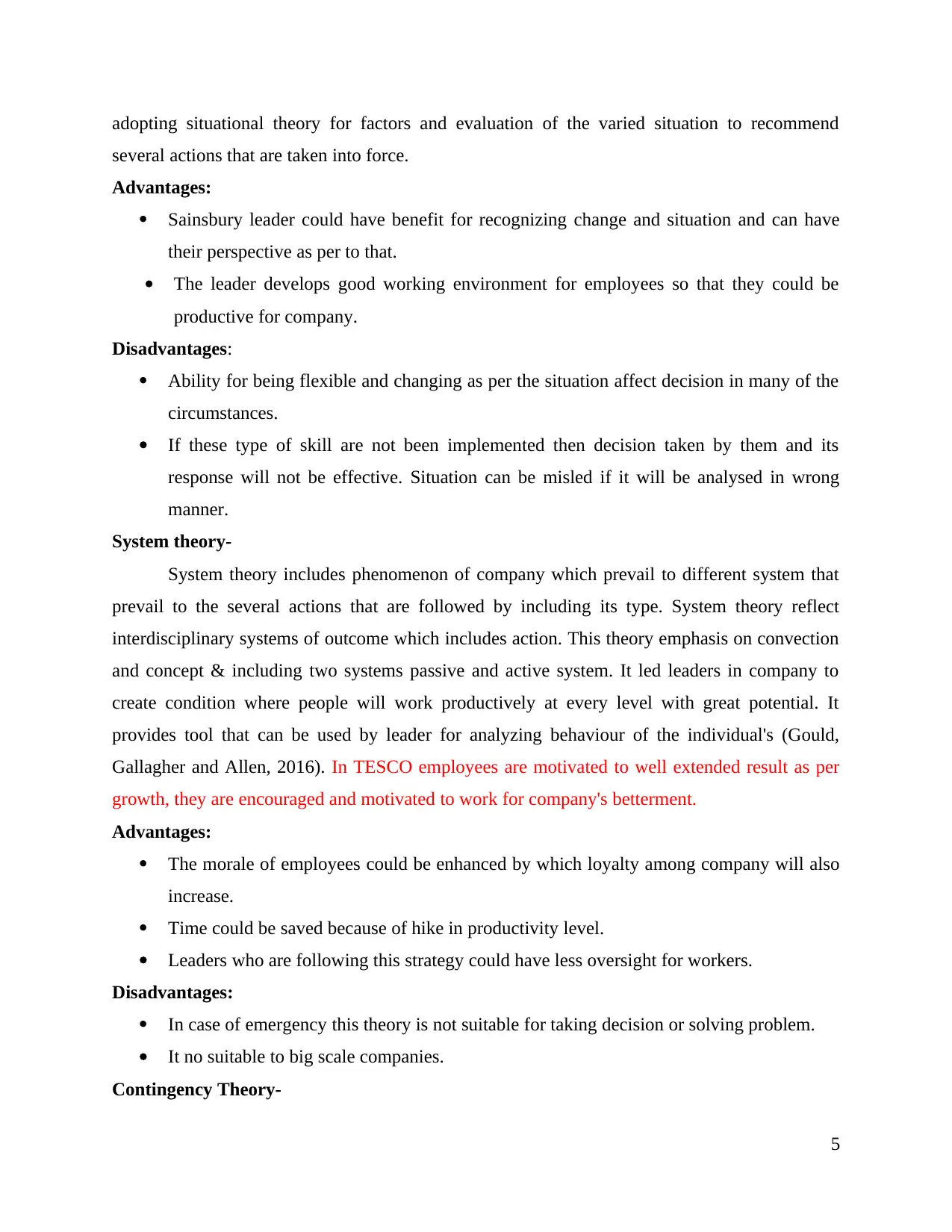
adopting situational theory for factors and evaluation of the varied situation to recommend
several actions that are taken into force.
Advantages:
Sainsbury leader could have benefit for recognizing change and situation and can have
their perspective as per to that.
The leader develops good working environment for employees so that they could be
productive for company.
Disadvantages:
Ability for being flexible and changing as per the situation affect decision in many of the
circumstances.
If these type of skill are not been implemented then decision taken by them and its
response will not be effective. Situation can be misled if it will be analysed in wrong
manner.
System theory-
System theory includes phenomenon of company which prevail to different system that
prevail to the several actions that are followed by including its type. System theory reflect
interdisciplinary systems of outcome which includes action. This theory emphasis on convection
and concept & including two systems passive and active system. It led leaders in company to
create condition where people will work productively at every level with great potential. It
provides tool that can be used by leader for analyzing behaviour of the individual's (Gould,
Gallagher and Allen, 2016). In TESCO employees are motivated to well extended result as per
growth, they are encouraged and motivated to work for company's betterment.
Advantages:
The morale of employees could be enhanced by which loyalty among company will also
increase.
Time could be saved because of hike in productivity level.
Leaders who are following this strategy could have less oversight for workers.
Disadvantages:
In case of emergency this theory is not suitable for taking decision or solving problem.
It no suitable to big scale companies.
Contingency Theory-
5
several actions that are taken into force.
Advantages:
Sainsbury leader could have benefit for recognizing change and situation and can have
their perspective as per to that.
The leader develops good working environment for employees so that they could be
productive for company.
Disadvantages:
Ability for being flexible and changing as per the situation affect decision in many of the
circumstances.
If these type of skill are not been implemented then decision taken by them and its
response will not be effective. Situation can be misled if it will be analysed in wrong
manner.
System theory-
System theory includes phenomenon of company which prevail to different system that
prevail to the several actions that are followed by including its type. System theory reflect
interdisciplinary systems of outcome which includes action. This theory emphasis on convection
and concept & including two systems passive and active system. It led leaders in company to
create condition where people will work productively at every level with great potential. It
provides tool that can be used by leader for analyzing behaviour of the individual's (Gould,
Gallagher and Allen, 2016). In TESCO employees are motivated to well extended result as per
growth, they are encouraged and motivated to work for company's betterment.
Advantages:
The morale of employees could be enhanced by which loyalty among company will also
increase.
Time could be saved because of hike in productivity level.
Leaders who are following this strategy could have less oversight for workers.
Disadvantages:
In case of emergency this theory is not suitable for taking decision or solving problem.
It no suitable to big scale companies.
Contingency Theory-
5
Paraphrase This Document
Need a fresh take? Get an instant paraphrase of this document with our AI Paraphraser
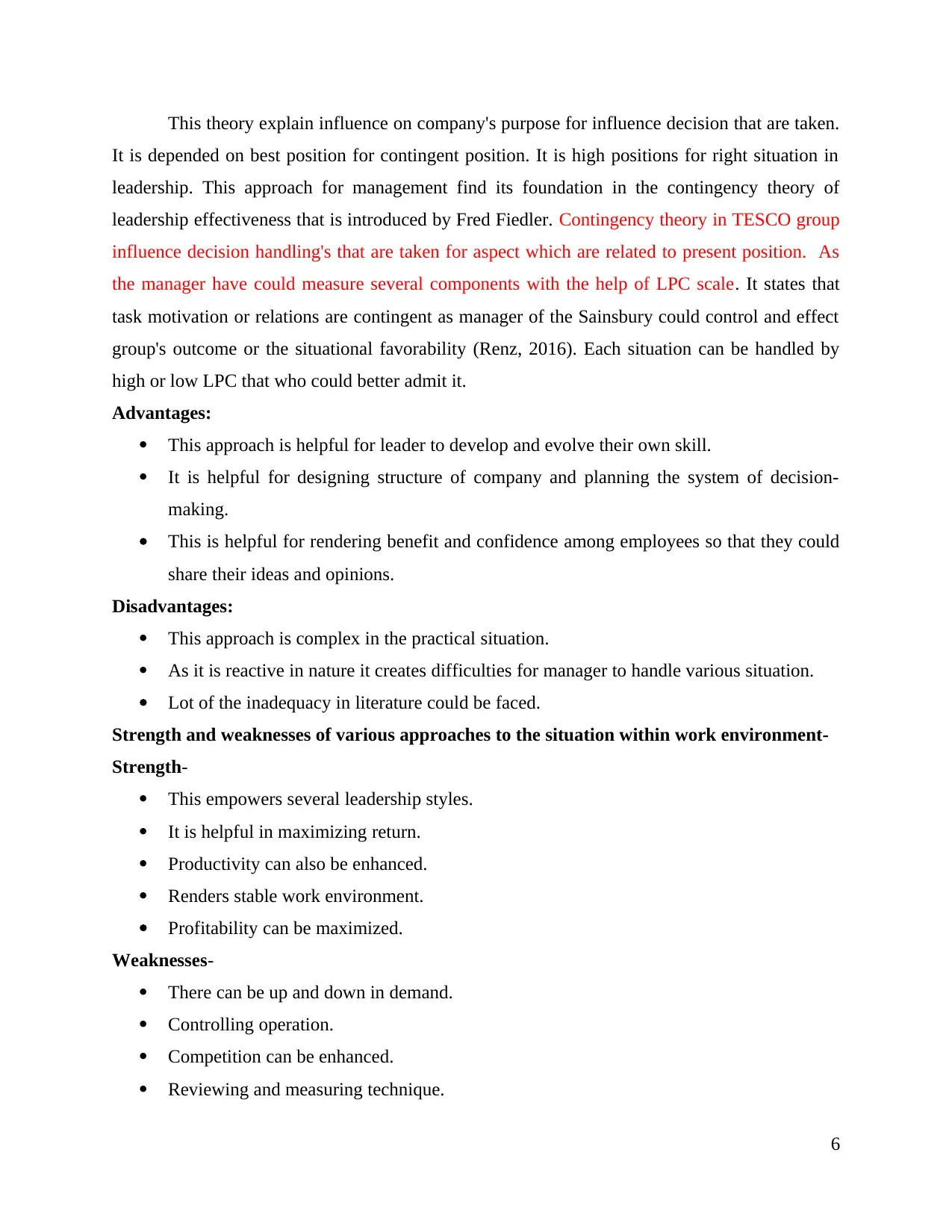
This theory explain influence on company's purpose for influence decision that are taken.
It is depended on best position for contingent position. It is high positions for right situation in
leadership. This approach for management find its foundation in the contingency theory of
leadership effectiveness that is introduced by Fred Fiedler. Contingency theory in TESCO group
influence decision handling's that are taken for aspect which are related to present position. As
the manager have could measure several components with the help of LPC scale. It states that
task motivation or relations are contingent as manager of the Sainsbury could control and effect
group's outcome or the situational favorability (Renz, 2016). Each situation can be handled by
high or low LPC that who could better admit it.
Advantages:
This approach is helpful for leader to develop and evolve their own skill.
It is helpful for designing structure of company and planning the system of decision-
making.
This is helpful for rendering benefit and confidence among employees so that they could
share their ideas and opinions.
Disadvantages:
This approach is complex in the practical situation.
As it is reactive in nature it creates difficulties for manager to handle various situation.
Lot of the inadequacy in literature could be faced.
Strength and weaknesses of various approaches to the situation within work environment-
Strength-
This empowers several leadership styles.
It is helpful in maximizing return.
Productivity can also be enhanced.
Renders stable work environment.
Profitability can be maximized.
Weaknesses-
There can be up and down in demand.
Controlling operation.
Competition can be enhanced.
Reviewing and measuring technique.
6
It is depended on best position for contingent position. It is high positions for right situation in
leadership. This approach for management find its foundation in the contingency theory of
leadership effectiveness that is introduced by Fred Fiedler. Contingency theory in TESCO group
influence decision handling's that are taken for aspect which are related to present position. As
the manager have could measure several components with the help of LPC scale. It states that
task motivation or relations are contingent as manager of the Sainsbury could control and effect
group's outcome or the situational favorability (Renz, 2016). Each situation can be handled by
high or low LPC that who could better admit it.
Advantages:
This approach is helpful for leader to develop and evolve their own skill.
It is helpful for designing structure of company and planning the system of decision-
making.
This is helpful for rendering benefit and confidence among employees so that they could
share their ideas and opinions.
Disadvantages:
This approach is complex in the practical situation.
As it is reactive in nature it creates difficulties for manager to handle various situation.
Lot of the inadequacy in literature could be faced.
Strength and weaknesses of various approaches to the situation within work environment-
Strength-
This empowers several leadership styles.
It is helpful in maximizing return.
Productivity can also be enhanced.
Renders stable work environment.
Profitability can be maximized.
Weaknesses-
There can be up and down in demand.
Controlling operation.
Competition can be enhanced.
Reviewing and measuring technique.
6
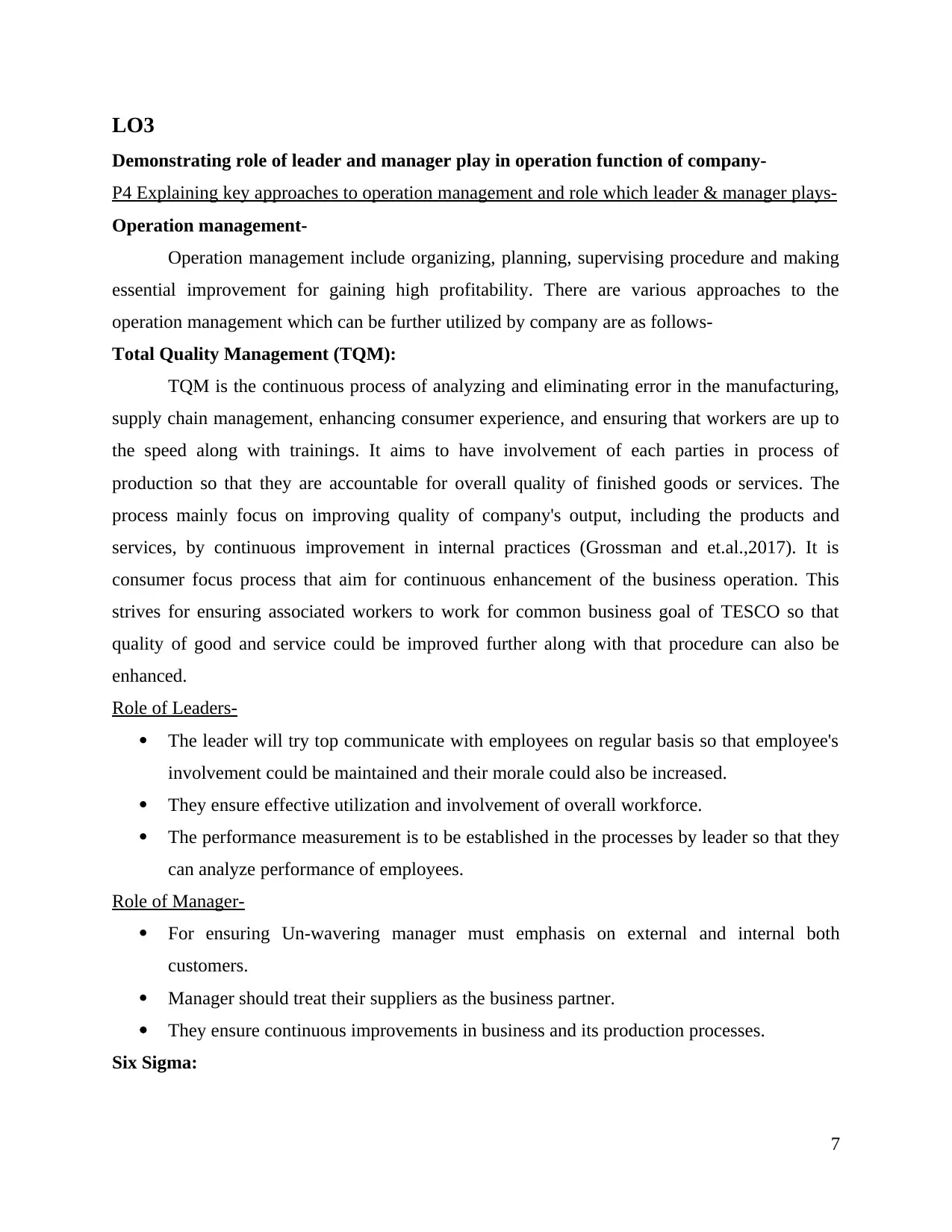
LO3
Demonstrating role of leader and manager play in operation function of company-
P4 Explaining key approaches to operation management and role which leader & manager plays-
Operation management-
Operation management include organizing, planning, supervising procedure and making
essential improvement for gaining high profitability. There are various approaches to the
operation management which can be further utilized by company are as follows-
Total Quality Management (TQM):
TQM is the continuous process of analyzing and eliminating error in the manufacturing,
supply chain management, enhancing consumer experience, and ensuring that workers are up to
the speed along with trainings. It aims to have involvement of each parties in process of
production so that they are accountable for overall quality of finished goods or services. The
process mainly focus on improving quality of company's output, including the products and
services, by continuous improvement in internal practices (Grossman and et.al.,2017). It is
consumer focus process that aim for continuous enhancement of the business operation. This
strives for ensuring associated workers to work for common business goal of TESCO so that
quality of good and service could be improved further along with that procedure can also be
enhanced.
Role of Leaders-
The leader will try top communicate with employees on regular basis so that employee's
involvement could be maintained and their morale could also be increased.
They ensure effective utilization and involvement of overall workforce.
The performance measurement is to be established in the processes by leader so that they
can analyze performance of employees.
Role of Manager-
For ensuring Un-wavering manager must emphasis on external and internal both
customers.
Manager should treat their suppliers as the business partner.
They ensure continuous improvements in business and its production processes.
Six Sigma:
7
Demonstrating role of leader and manager play in operation function of company-
P4 Explaining key approaches to operation management and role which leader & manager plays-
Operation management-
Operation management include organizing, planning, supervising procedure and making
essential improvement for gaining high profitability. There are various approaches to the
operation management which can be further utilized by company are as follows-
Total Quality Management (TQM):
TQM is the continuous process of analyzing and eliminating error in the manufacturing,
supply chain management, enhancing consumer experience, and ensuring that workers are up to
the speed along with trainings. It aims to have involvement of each parties in process of
production so that they are accountable for overall quality of finished goods or services. The
process mainly focus on improving quality of company's output, including the products and
services, by continuous improvement in internal practices (Grossman and et.al.,2017). It is
consumer focus process that aim for continuous enhancement of the business operation. This
strives for ensuring associated workers to work for common business goal of TESCO so that
quality of good and service could be improved further along with that procedure can also be
enhanced.
Role of Leaders-
The leader will try top communicate with employees on regular basis so that employee's
involvement could be maintained and their morale could also be increased.
They ensure effective utilization and involvement of overall workforce.
The performance measurement is to be established in the processes by leader so that they
can analyze performance of employees.
Role of Manager-
For ensuring Un-wavering manager must emphasis on external and internal both
customers.
Manager should treat their suppliers as the business partner.
They ensure continuous improvements in business and its production processes.
Six Sigma:
7
⊘ This is a preview!⊘
Do you want full access?
Subscribe today to unlock all pages.

Trusted by 1+ million students worldwide
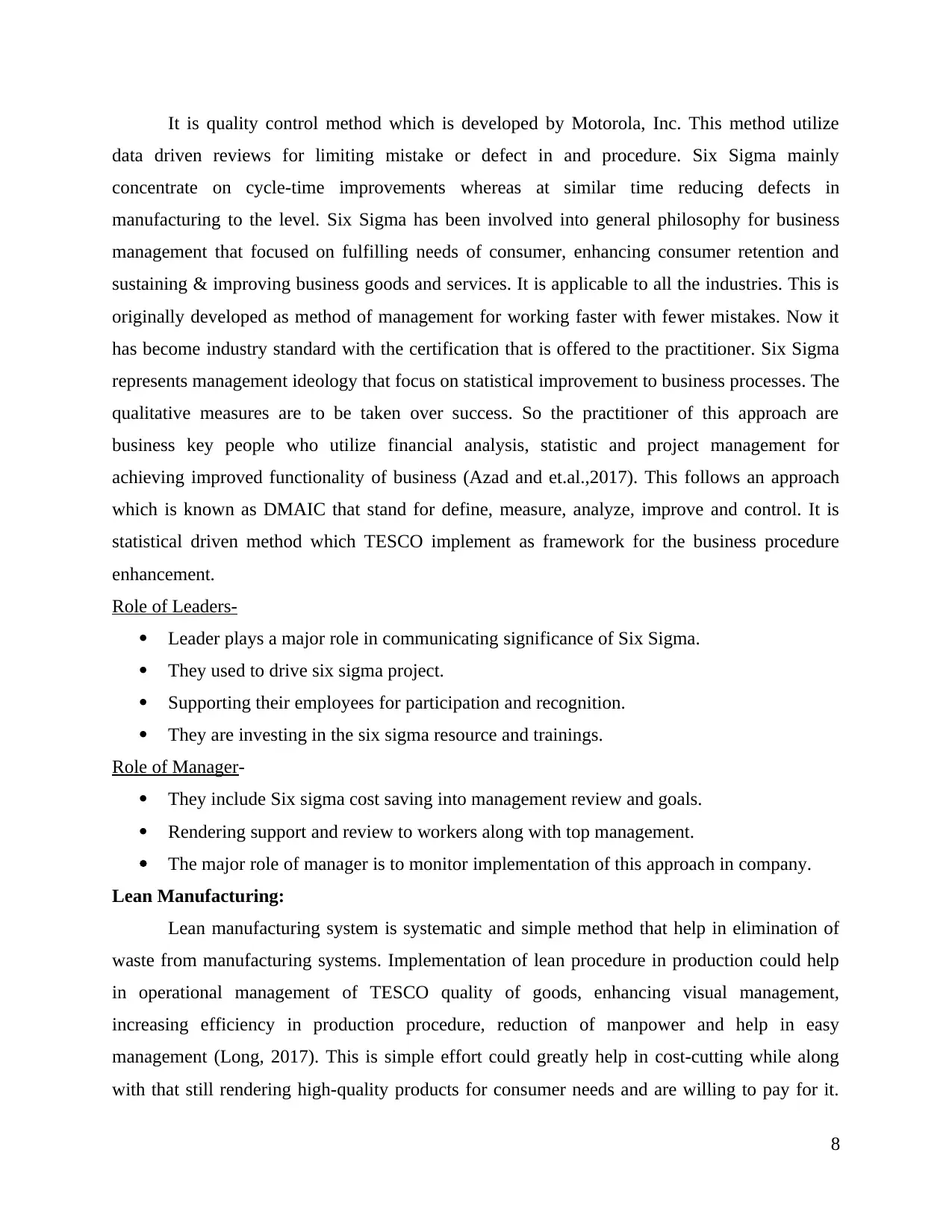
It is quality control method which is developed by Motorola, Inc. This method utilize
data driven reviews for limiting mistake or defect in and procedure. Six Sigma mainly
concentrate on cycle-time improvements whereas at similar time reducing defects in
manufacturing to the level. Six Sigma has been involved into general philosophy for business
management that focused on fulfilling needs of consumer, enhancing consumer retention and
sustaining & improving business goods and services. It is applicable to all the industries. This is
originally developed as method of management for working faster with fewer mistakes. Now it
has become industry standard with the certification that is offered to the practitioner. Six Sigma
represents management ideology that focus on statistical improvement to business processes. The
qualitative measures are to be taken over success. So the practitioner of this approach are
business key people who utilize financial analysis, statistic and project management for
achieving improved functionality of business (Azad and et.al.,2017). This follows an approach
which is known as DMAIC that stand for define, measure, analyze, improve and control. It is
statistical driven method which TESCO implement as framework for the business procedure
enhancement.
Role of Leaders-
Leader plays a major role in communicating significance of Six Sigma.
They used to drive six sigma project.
Supporting their employees for participation and recognition.
They are investing in the six sigma resource and trainings.
Role of Manager-
They include Six sigma cost saving into management review and goals.
Rendering support and review to workers along with top management.
The major role of manager is to monitor implementation of this approach in company.
Lean Manufacturing:
Lean manufacturing system is systematic and simple method that help in elimination of
waste from manufacturing systems. Implementation of lean procedure in production could help
in operational management of TESCO quality of goods, enhancing visual management,
increasing efficiency in production procedure, reduction of manpower and help in easy
management (Long, 2017). This is simple effort could greatly help in cost-cutting while along
with that still rendering high-quality products for consumer needs and are willing to pay for it.
8
data driven reviews for limiting mistake or defect in and procedure. Six Sigma mainly
concentrate on cycle-time improvements whereas at similar time reducing defects in
manufacturing to the level. Six Sigma has been involved into general philosophy for business
management that focused on fulfilling needs of consumer, enhancing consumer retention and
sustaining & improving business goods and services. It is applicable to all the industries. This is
originally developed as method of management for working faster with fewer mistakes. Now it
has become industry standard with the certification that is offered to the practitioner. Six Sigma
represents management ideology that focus on statistical improvement to business processes. The
qualitative measures are to be taken over success. So the practitioner of this approach are
business key people who utilize financial analysis, statistic and project management for
achieving improved functionality of business (Azad and et.al.,2017). This follows an approach
which is known as DMAIC that stand for define, measure, analyze, improve and control. It is
statistical driven method which TESCO implement as framework for the business procedure
enhancement.
Role of Leaders-
Leader plays a major role in communicating significance of Six Sigma.
They used to drive six sigma project.
Supporting their employees for participation and recognition.
They are investing in the six sigma resource and trainings.
Role of Manager-
They include Six sigma cost saving into management review and goals.
Rendering support and review to workers along with top management.
The major role of manager is to monitor implementation of this approach in company.
Lean Manufacturing:
Lean manufacturing system is systematic and simple method that help in elimination of
waste from manufacturing systems. Implementation of lean procedure in production could help
in operational management of TESCO quality of goods, enhancing visual management,
increasing efficiency in production procedure, reduction of manpower and help in easy
management (Long, 2017). This is simple effort could greatly help in cost-cutting while along
with that still rendering high-quality products for consumer needs and are willing to pay for it.
8
Paraphrase This Document
Need a fresh take? Get an instant paraphrase of this document with our AI Paraphraser
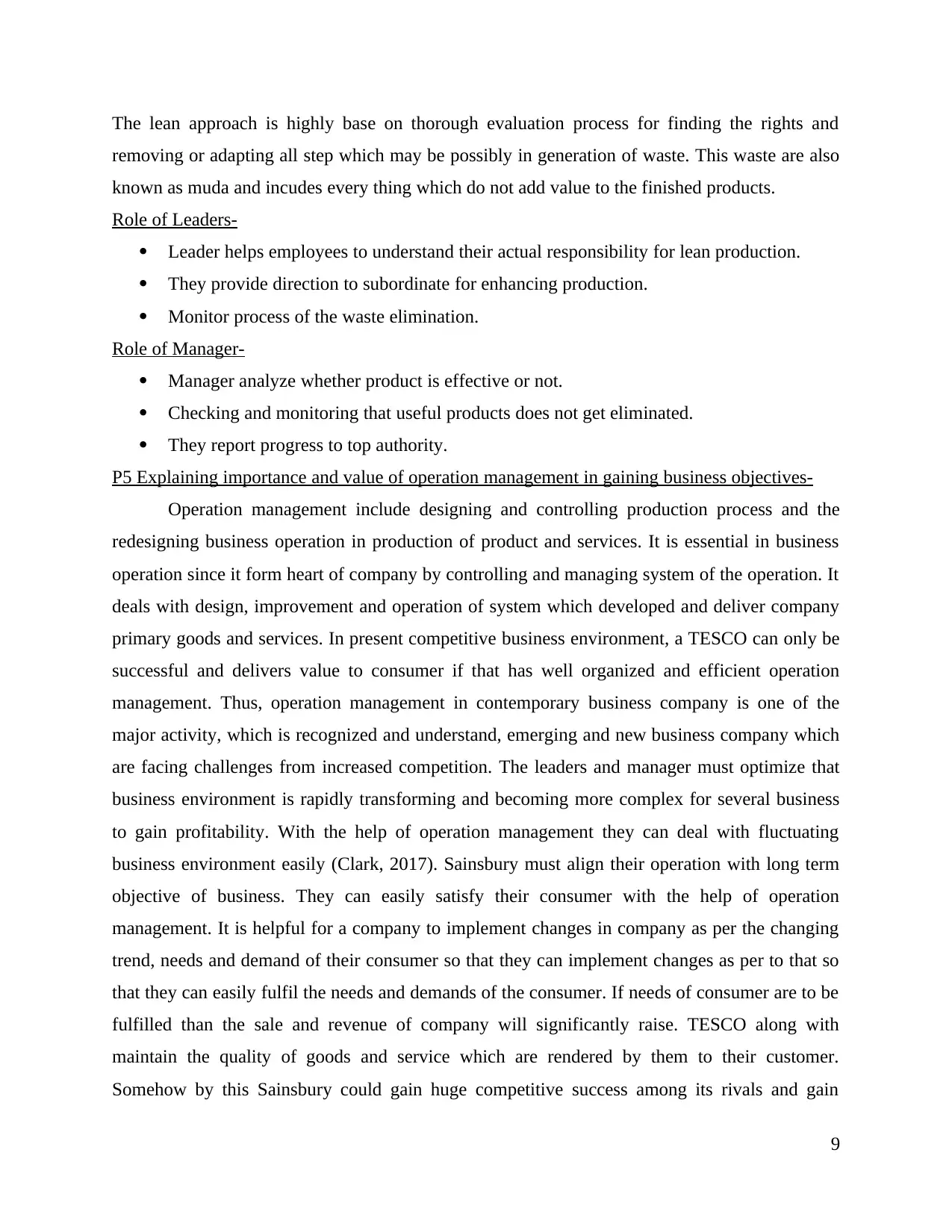
The lean approach is highly base on thorough evaluation process for finding the rights and
removing or adapting all step which may be possibly in generation of waste. This waste are also
known as muda and incudes every thing which do not add value to the finished products.
Role of Leaders-
Leader helps employees to understand their actual responsibility for lean production.
They provide direction to subordinate for enhancing production.
Monitor process of the waste elimination.
Role of Manager-
Manager analyze whether product is effective or not.
Checking and monitoring that useful products does not get eliminated.
They report progress to top authority.
P5 Explaining importance and value of operation management in gaining business objectives-
Operation management include designing and controlling production process and the
redesigning business operation in production of product and services. It is essential in business
operation since it form heart of company by controlling and managing system of the operation. It
deals with design, improvement and operation of system which developed and deliver company
primary goods and services. In present competitive business environment, a TESCO can only be
successful and delivers value to consumer if that has well organized and efficient operation
management. Thus, operation management in contemporary business company is one of the
major activity, which is recognized and understand, emerging and new business company which
are facing challenges from increased competition. The leaders and manager must optimize that
business environment is rapidly transforming and becoming more complex for several business
to gain profitability. With the help of operation management they can deal with fluctuating
business environment easily (Clark, 2017). Sainsbury must align their operation with long term
objective of business. They can easily satisfy their consumer with the help of operation
management. It is helpful for a company to implement changes in company as per the changing
trend, needs and demand of their consumer so that they can implement changes as per to that so
that they can easily fulfil the needs and demands of the consumer. If needs of consumer are to be
fulfilled than the sale and revenue of company will significantly raise. TESCO along with
maintain the quality of goods and service which are rendered by them to their customer.
Somehow by this Sainsbury could gain huge competitive success among its rivals and gain
9
removing or adapting all step which may be possibly in generation of waste. This waste are also
known as muda and incudes every thing which do not add value to the finished products.
Role of Leaders-
Leader helps employees to understand their actual responsibility for lean production.
They provide direction to subordinate for enhancing production.
Monitor process of the waste elimination.
Role of Manager-
Manager analyze whether product is effective or not.
Checking and monitoring that useful products does not get eliminated.
They report progress to top authority.
P5 Explaining importance and value of operation management in gaining business objectives-
Operation management include designing and controlling production process and the
redesigning business operation in production of product and services. It is essential in business
operation since it form heart of company by controlling and managing system of the operation. It
deals with design, improvement and operation of system which developed and deliver company
primary goods and services. In present competitive business environment, a TESCO can only be
successful and delivers value to consumer if that has well organized and efficient operation
management. Thus, operation management in contemporary business company is one of the
major activity, which is recognized and understand, emerging and new business company which
are facing challenges from increased competition. The leaders and manager must optimize that
business environment is rapidly transforming and becoming more complex for several business
to gain profitability. With the help of operation management they can deal with fluctuating
business environment easily (Clark, 2017). Sainsbury must align their operation with long term
objective of business. They can easily satisfy their consumer with the help of operation
management. It is helpful for a company to implement changes in company as per the changing
trend, needs and demand of their consumer so that they can implement changes as per to that so
that they can easily fulfil the needs and demands of the consumer. If needs of consumer are to be
fulfilled than the sale and revenue of company will significantly raise. TESCO along with
maintain the quality of goods and service which are rendered by them to their customer.
Somehow by this Sainsbury could gain huge competitive success among its rivals and gain
9
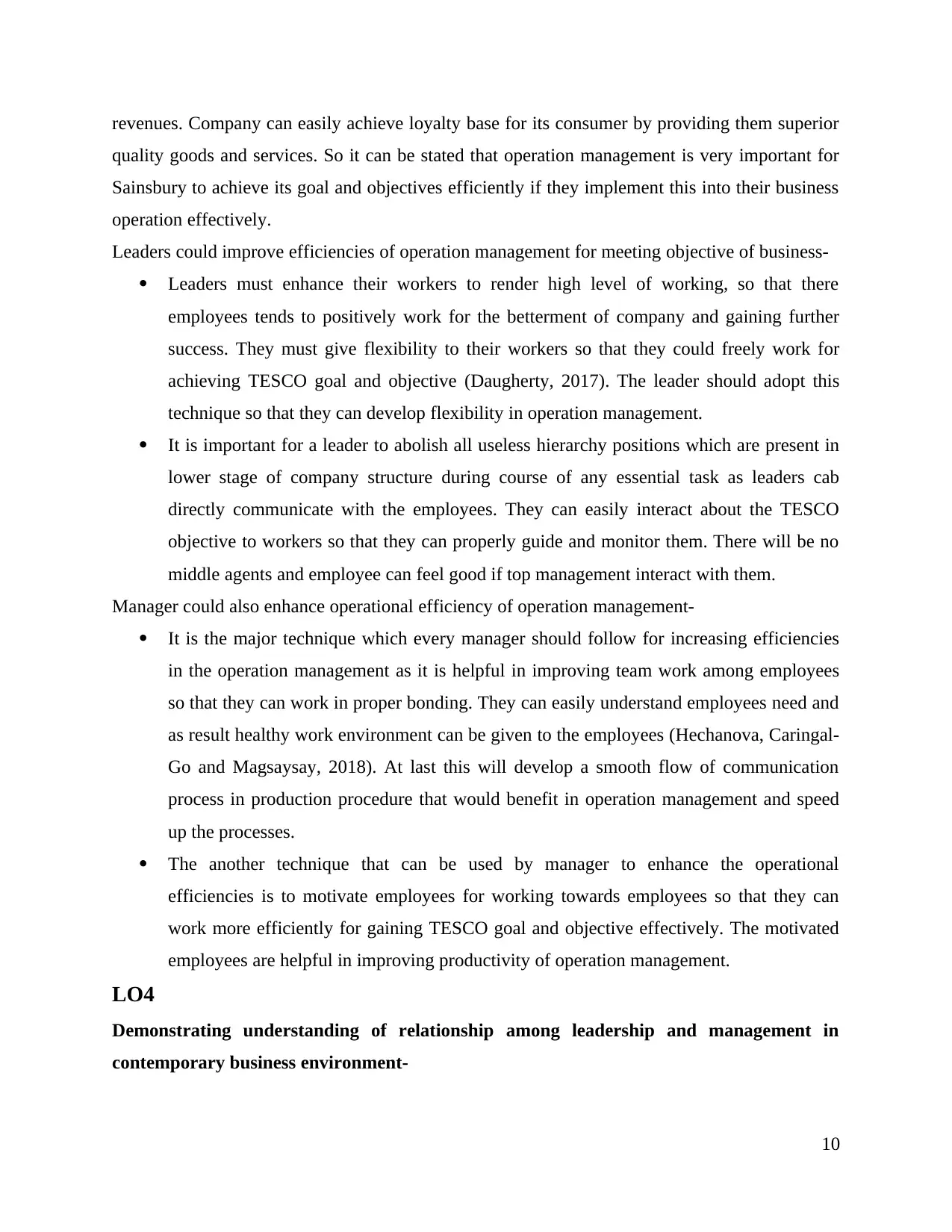
revenues. Company can easily achieve loyalty base for its consumer by providing them superior
quality goods and services. So it can be stated that operation management is very important for
Sainsbury to achieve its goal and objectives efficiently if they implement this into their business
operation effectively.
Leaders could improve efficiencies of operation management for meeting objective of business-
Leaders must enhance their workers to render high level of working, so that there
employees tends to positively work for the betterment of company and gaining further
success. They must give flexibility to their workers so that they could freely work for
achieving TESCO goal and objective (Daugherty, 2017). The leader should adopt this
technique so that they can develop flexibility in operation management.
It is important for a leader to abolish all useless hierarchy positions which are present in
lower stage of company structure during course of any essential task as leaders cab
directly communicate with the employees. They can easily interact about the TESCO
objective to workers so that they can properly guide and monitor them. There will be no
middle agents and employee can feel good if top management interact with them.
Manager could also enhance operational efficiency of operation management-
It is the major technique which every manager should follow for increasing efficiencies
in the operation management as it is helpful in improving team work among employees
so that they can work in proper bonding. They can easily understand employees need and
as result healthy work environment can be given to the employees (Hechanova, Caringal-
Go and Magsaysay, 2018). At last this will develop a smooth flow of communication
process in production procedure that would benefit in operation management and speed
up the processes.
The another technique that can be used by manager to enhance the operational
efficiencies is to motivate employees for working towards employees so that they can
work more efficiently for gaining TESCO goal and objective effectively. The motivated
employees are helpful in improving productivity of operation management.
LO4
Demonstrating understanding of relationship among leadership and management in
contemporary business environment-
10
quality goods and services. So it can be stated that operation management is very important for
Sainsbury to achieve its goal and objectives efficiently if they implement this into their business
operation effectively.
Leaders could improve efficiencies of operation management for meeting objective of business-
Leaders must enhance their workers to render high level of working, so that there
employees tends to positively work for the betterment of company and gaining further
success. They must give flexibility to their workers so that they could freely work for
achieving TESCO goal and objective (Daugherty, 2017). The leader should adopt this
technique so that they can develop flexibility in operation management.
It is important for a leader to abolish all useless hierarchy positions which are present in
lower stage of company structure during course of any essential task as leaders cab
directly communicate with the employees. They can easily interact about the TESCO
objective to workers so that they can properly guide and monitor them. There will be no
middle agents and employee can feel good if top management interact with them.
Manager could also enhance operational efficiency of operation management-
It is the major technique which every manager should follow for increasing efficiencies
in the operation management as it is helpful in improving team work among employees
so that they can work in proper bonding. They can easily understand employees need and
as result healthy work environment can be given to the employees (Hechanova, Caringal-
Go and Magsaysay, 2018). At last this will develop a smooth flow of communication
process in production procedure that would benefit in operation management and speed
up the processes.
The another technique that can be used by manager to enhance the operational
efficiencies is to motivate employees for working towards employees so that they can
work more efficiently for gaining TESCO goal and objective effectively. The motivated
employees are helpful in improving productivity of operation management.
LO4
Demonstrating understanding of relationship among leadership and management in
contemporary business environment-
10
⊘ This is a preview!⊘
Do you want full access?
Subscribe today to unlock all pages.

Trusted by 1+ million students worldwide
1 out of 15
Related Documents
Your All-in-One AI-Powered Toolkit for Academic Success.
+13062052269
info@desklib.com
Available 24*7 on WhatsApp / Email
![[object Object]](/_next/static/media/star-bottom.7253800d.svg)
Unlock your academic potential
Copyright © 2020–2025 A2Z Services. All Rights Reserved. Developed and managed by ZUCOL.





